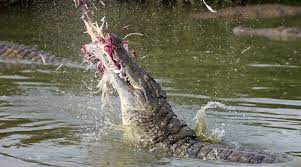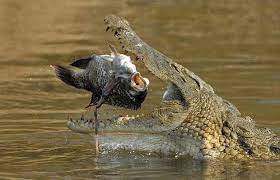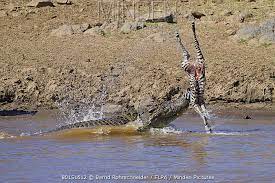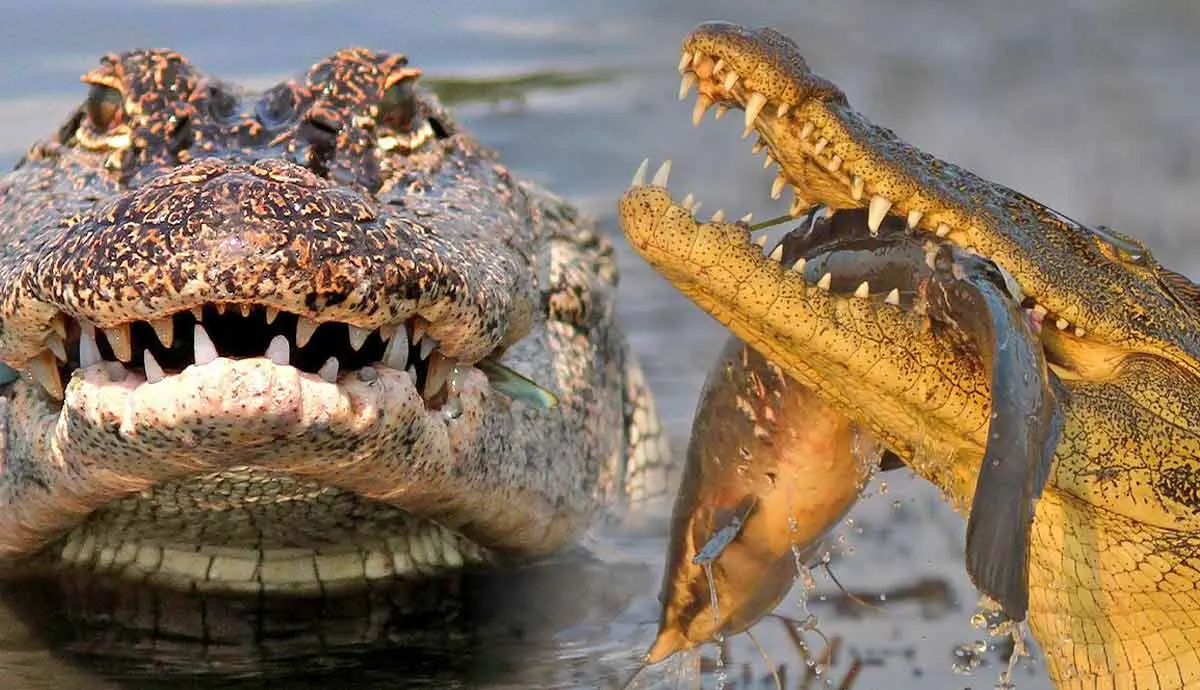How Nile Crocodile Diet Changes Based on Habitat
How Nile Crocodile Diet Changes Based on Habitat The Nile crocodile (Crocodylus niloticus) is one of the most formidable and adaptive predators in Africa, with a diverse diet that has allowed it to thrive in a range of ecosystems. As opportunistic feeders, these crocodiles adjust their diet according to the availability of prey, making them versatile hunters in varying habitats. From rivers and lakes to estuaries and even human-modified areas, the diet of Nile crocodiles changes based on the unique environmental conditions of each setting. Understanding these dietary shifts not only highlights the crocodile’s adaptability but also reveals insights crucial for their conservation and management.
General Diet of Nile Crocodiles

Nile crocodiles are carnivores with a broad diet that includes fish, birds, reptiles, and mammals. They rely heavily on their environment to determine what they consume, often targeting prey that is easiest to capture and available in abundance. As ambush predators, Nile crocodiles are skilled at lying in wait for unsuspecting animals to come close enough for a sudden attack. Their diet varies with age and size; juveniles primarily eat insects and small fish, while adults can take down large prey, including antelope, buffalo, and occasionally even larger animals.
Habitat Types and Their Influence on Diet
The Nile crocodile inhabits a wide range of environments, each providing different types of food sources. This section explores how specific habitat types — including rivers, lakes, estuaries, and human-modified landscapes — affect the crocodile’s dietary habits.
Here’s a table summarizing “How Nile Crocodile Diet Changes Based on Habitat”:
| Habitat Type | Characteristics | Primary Diet Components | Seasonal/Regional Influence |
|---|---|---|---|
| Riverine Habitat | Flowing water, seasonal migrations of large animals | Fish, migrating mammals (e.g., wildebeest, zebra) | Increased large prey during migration seasons; variable fish availability by season |
| Lake and Wetland Habitat | Still water, seasonal fluctuations in water levels | Fish, waterbirds, amphibians | Fish plentiful during wet season; reliance on birds and amphibians in dry season |
| Estuarine and Mangrove Habitat | Brackish water, mix of saltwater and freshwater ecosystems | Crabs, crustaceans, fish, amphibians | Prey distribution varies with salinity; diet shifts to salt-tolerant species |
| Human-Influenced Habitat | Areas altered by human activity (urban rivers, artificial lakes) | Livestock, human waste, pets | Increased human-wildlife interaction; diet includes unconventional food sources |
| Seasonal and Regional Variations | Differences due to climate, ecosystem, and local prey types | Fish, birds, small mammals | Wet season: abundant fish; Dry season: reliance on small mammals and birds |
Riverine Habitat
In river habitats, Nile crocodiles primarily hunt fish, which is abundant in flowing water ecosystems. River environments often provide a steady supply of medium-sized fish, which make up a large portion of the crocodile’s diet. However, larger animals such as wildebeest, zebra, and antelope frequently cross rivers during seasonal migrations, offering Nile crocodiles opportunities to capture substantial prey. Seasonal changes impact the river’s water levels, altering the availability of both small and large prey and creating unique hunting opportunities during annual migrations.
Lake and Wetland Habitats

Lakes and wetlands offer a rich variety of prey, from fish to migratory birds. Waterbirds, which nest around lakes and wetlands, become a significant dietary component, especially during the dry season when they congregate near diminishing water sources. In these habitats, Nile crocodiles may also hunt other reptiles and amphibians. Water levels in lakes and wetlands often fluctuate due to seasonal rains, influencing the abundance of fish and bird populations. During droughts, these crocodiles may rely more heavily on birds and other readily available animals congregating around shrinking water sources.
Estuarine and Mangrove Habitats

In estuarine and mangrove areas where saltwater and freshwater mix, Nile crocodiles are exposed to a different range of prey. These brackish environments offer species such as crabs, crustaceans, fish, and amphibians. Although fish remain a dietary staple, the crocodiles also consume various marine species adapted to these unique ecosystems. In estuaries, the salinity of the water can impact prey distribution, requiring crocodiles to shift their diet to match the abundance of salt-tolerant species.
Human-Influenced Habitats
As human populations expand, Nile crocodiles increasingly inhabit areas altered by human activity, such as rivers modified by dams, urban waterways, and artificial lakes. In these regions, they often encounter human waste, livestock, and even pet animals as potential food sources. Nile crocodiles in these habitats may adapt their diet based on new food opportunities, which can sometimes lead to conflicts with humans. This adaptation, while demonstrating their flexibility, often brings them into close contact with people, leading to increased risks for both crocodiles and human populations.
Seasonal and Regional Variations in Diet

Across Africa, Nile crocodiles exhibit seasonal variations in their diet due to changing prey availability. In the wet season, rivers flood, and fish become more abundant, allowing the crocodiles to focus on this plentiful resource. In contrast, during the dry season, crocodiles may rely on birds and small mammals that gather around remaining water sources. Regional variations also play a role; crocodiles in arid areas are more dependent on migratory birds and mammals, while those in wetter regions have a steady supply of fish year-round.
Conclusion
The diet of the Nile crocodile is a testament to its adaptability and survival skills, allowing it to thrive in a diverse range of habitats. From fish in rivers to birds in lakes, crustaceans in estuaries, and even livestock in human-modified areas, the Nile crocodile’s diet shifts in response to its environment. These adaptations highlight the importance of understanding habitat-based dietary patterns for effective conservation and management of Nile crocodile populations. Studying these dietary habits not only provides insight into the ecology of these impressive reptiles but also helps address challenges arising from human-wildlife interactions in shared environments.
Here are some tips for understanding how the Nile crocodile’s diet changes based on its habitat:
Observe the Habitat’s Prey Availability
- The diet of a Nile crocodile largely depends on what prey is abundant in its habitat. Pay attention to the local wildlife, such as fish, birds, and mammals, as these will influence what the crocodiles feed on. Rivers will typically have more fish, while lakes and wetlands may offer more birds and amphibians.
Consider Seasonal Changes
- Seasonal variations play a big role in the crocodile’s diet. During the wet season, water levels rise, and fish are abundant, while in the dry season, prey like birds, small mammals, and reptiles may become more important. Be aware of local climate patterns to predict these shifts in diet.
Adapt to Human-Modified Environments
- In human-influenced habitats, such as urban rivers and reservoirs, Nile crocodiles may consume livestock, pets, and even human waste. These food sources could lead to more frequent human-wildlife conflicts, so understanding these behaviors is key for safety and conservation efforts.
Understand Habitat-Specific Behavior
- Different habitats require different hunting techniques. In rivers, crocodiles may hunt larger mammals that cross the water, while in estuaries, they might focus on crustaceans or fish that thrive in brackish water. Study the specific hunting patterns within each ecosystem to gain a deeper understanding of their dietary habits.
Look for Signs of Prey Migration
- Many large prey species, like wildebeest or zebra, migrate seasonally. Nile crocodiles often take advantage of these migrations, waiting for the perfect moment to ambush. Knowing the timing and routes of these migrations can give insights into when crocodiles may switch their diet to larger prey.
Monitor Habitat Changes
- As habitats change, either due to seasonal shifts or human activity, the crocodile’s diet may shift as well. If water levels in lakes or rivers drop, crocodiles may turn to other food sources, such as birds or small mammals. Regular monitoring of the ecosystem’s condition helps understand how their diet adapts over time.
Study Crocodile Growth and Diet Shifts
- Juvenile crocodiles primarily eat smaller prey, such as insects and small fish, but as they grow, they move on to larger mammals and birds. Understanding this progression is important when studying how diet changes with the crocodile’s size and age.
Respect Crocodile Habitat Boundaries
- Crocodiles are territorial, especially in habitats where food sources are scarce. Understanding their territory and feeding patterns can help minimize human-wildlife conflict and ensure their protection in the wild.
Here are some Frequently Asked Questions
What is the primary diet of Nile crocodiles?
Nile crocodiles are carnivores and their diet primarily consists of fish, birds, reptiles, and mammals. They are opportunistic feeders, meaning they eat whatever prey is available and easiest to capture in their habitat.
How does the habitat affect a Nile crocodile’s diet?
The habitat plays a significant role in determining the types of prey available to Nile crocodiles. In river habitats, they primarily hunt fish and migrating mammals. In lakes and wetlands, their diet includes fish, waterbirds, and amphibians, while in estuaries, they focus more on crabs, crustaceans, and fish adapted to brackish water.
Does the Nile crocodile’s diet change with the seasons?
Yes, the crocodile’s diet changes with the seasons. During the wet season, when fish are abundant, they consume more fish. In the dry season, when water levels drop and prey is concentrated, crocodiles may focus more on birds, small mammals, and reptiles that gather around shrinking water sources.
What happens to Nile crocodiles’ diet in human-influenced environments?
In human-influenced environments, such as urban rivers or artificial lakes, Nile crocodiles may consume livestock, pets, and even human waste. These food sources are less natural but can become an important part of their diet in these altered habitats. This shift often leads to more conflicts between humans and crocodiles.
How do Nile crocodiles hunt their prey?
Nile crocodiles are ambush predators. They typically remain motionless in the water, waiting for prey to come close enough to capture. They then use a powerful, sudden strike to grab their prey. In some habitats, such as rivers, crocodiles may also take advantage of migrating animals crossing the water.
Are there any prey species that Nile crocodiles prefer?
Nile crocodiles tend to prefer larger prey when available, such as antelope, buffalo, and zebra, especially during migration periods. However, their diet also depends on what is most abundant in their environment, such as fish in rivers or birds and amphibians in lakes.
Do Nile crocodiles eat differently based on their age or size?
Yes, juvenile Nile crocodiles primarily eat smaller prey, such as insects and small fish. As they grow larger, their diet expands to include larger prey, including mammals and birds. Their hunting strategies also evolve as they gain size and strength.
How do seasonal changes affect their diet in different habitats?
In riverine habitats, seasonal flooding brings an abundance of fish, making them the primary food source during the wet season. In contrast, during the dry season, Nile crocodiles in lakes and wetlands may rely more on birds, amphibians, and smaller mammals that gather near remaining water sources.
How do Nile crocodiles adapt to different types of prey in estuaries?
In estuarine habitats, where saltwater and freshwater mix, Nile crocodiles adapt to hunting salt-tolerant species like crabs, crustaceans, and fish. They may also feed on amphibians that thrive in brackish water. Their diet shifts to match the abundance of prey in these unique ecosystems.
Can Nile crocodiles survive in habitats with little prey?
Nile crocodiles are highly adaptable and can survive in environments where prey is scarce by relying on whatever food is available. In some human-modified habitats, they may even turn to scavenging, including eating livestock, waste, or pet animals. However, they are most successful in ecosystems with abundant natural prey.
